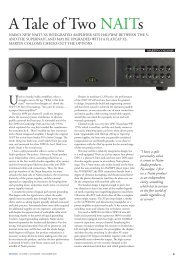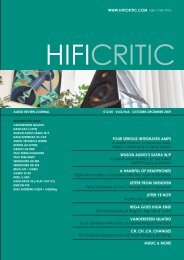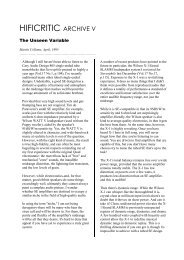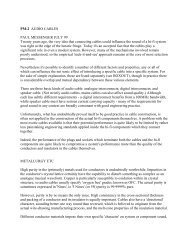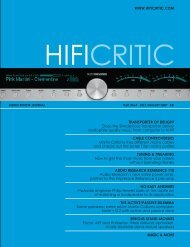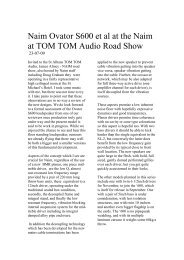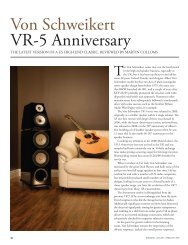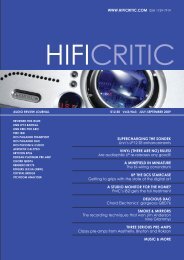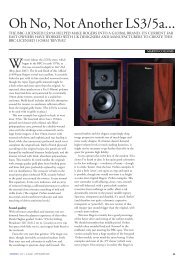HFC_issue8 1.indd - Hificritic.com
HFC_issue8 1.indd - Hificritic.com
HFC_issue8 1.indd - Hificritic.com
Create successful ePaper yourself
Turn your PDF publications into a flip-book with our unique Google optimized e-Paper software.
◆ REVIEW<br />
axial mid-to-treble (unsmoothed). There is a hint of upper<br />
bass depression, about 2dB, and a mildly lifted upper<br />
midrange; the bass is well tuned and reaches 38Hz -6dB,<br />
while the main trend meets finely toleranced +/- 2.5dB<br />
limits out to 20 kHz, and extends still further, to about<br />
34kHz for -6dB.<br />
The above axis trace holds up well, but a 7dB suckout<br />
is visible in the crossover region when measured at<br />
15 degrees below the bass driver. The crossover point is<br />
located at a relatively low 1.8kHz, thanks to the powerful<br />
wide-band tweeter. Despite the relatively large bass/mid<br />
unit, system integration is good, but ideally you should<br />
not listen with your ears much below the centre of the<br />
bass unit unless the enclosure is mounted on its side<br />
(tweeters inward).<br />
The hard work expended on reducing enclosure<br />
diffraction has paid off, for example in the 30 degree lateral<br />
response, which, like the Watt 8, is first rate. The 45 degree<br />
off-axis output is also very good, and the still smooth<br />
output only begins to fade more rapidly above 6kHz at a<br />
wide 60 degrees off-axis.<br />
The decay response seen in the waterfall display is<br />
impressive for its excellent driver integration (phase and<br />
frequency) and quite rapid decay, confirming the natural<br />
timbre, the very good subjective dynamics and substantial<br />
clarity. Using a stethoscope, stray sound radiation from<br />
the enclosure panels seems very low, and makes a minimal<br />
contribution to the sound output.<br />
Conclusions<br />
The substantial US-UK price differential forces me to<br />
make a split conclusion. In the UK this is an undeniably<br />
costly design, yet one built and finished to an exceptional<br />
standard, and it is hard to put a price on such excellence.<br />
These very good, <strong>com</strong>pact stand-mounts designs have<br />
a special voice and deliver their most natural sound when<br />
used as intended quite near a wall, so they have a special<br />
part to play as unobtrusive high quality speakers for more<br />
difficult room layouts. Here the Duette is as good as it<br />
gets, and is well capable of delivering the goods in a system<br />
costing as much as £40,000.<br />
I enjoyed its considerable transparency and retrieval<br />
of fine detail, its sense of performance and expressive<br />
dynamics, its healthy bass power and extension, and the<br />
fine sense of drive and involvement. It’s relatively easy to<br />
drive, efficient, with a natural and neutral tonal balance<br />
and very sweet treble. Many valve amplifiers will sing nicely<br />
with it.<br />
For US purchasers it actually constitutes fine value for<br />
money, while over here in Britain it still <strong>com</strong>fortably merits<br />
re<strong>com</strong>mendation.<br />
Wilson Audio Duette Frequency Response<br />
Wilson Audio Duette Impedance and Phase<br />
Wilson Audio Duette Waterfall<br />
HIFICRITIC MARCH / APRIL 2008 13




